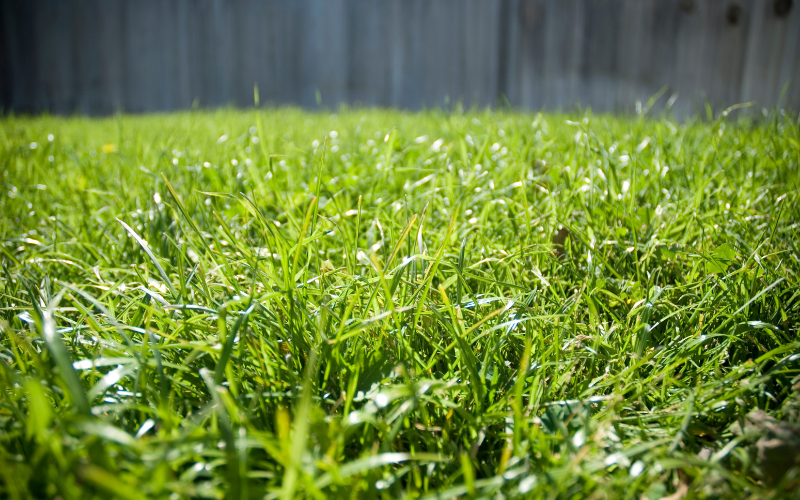The good news is that the answer to “how to get bermuda grass to spread” comes with many options. This is one of the most versatile grass types in warm-season climates as long as it has the resources it needs. It can spread in three completely different ways, though in terms of speed, one of these ways is superior.
How Does Bermuda Grass Spread?
Bermuda grass is a stolon-type grass that also produces rhizomes. It will also produce seeds that are more viable than other types of stolon-producing grass, but still not an ideal spreading method. There are 3 primary ways in which bermudagrass will spread.
Stolons
Stolons are long, root-like protrusions that blades grow just above and parallel to the ground. From each stolon, 3 to 4 blades of grass will spring up. Stolons can reach across the terrain and sink into the ground, producing a new clump of roots at its end which then produces more stolons. Even if the stolons between root clumps are severed, each individual plant will survive.
Rhizomes
Each clump is likely to set out a few stolons and may also set rhizomes. Rhizomes are the below-ground counterpart to the stolons, though rhizomes are more root-focused and will not grow blades of grass. Each rhizome will extend underground to create a new clump of roots, stolons, and grass above.
Seeds
Bermudagrass also spreads by setting out seeds. This is the slowest way to grow, establish, or get bermuda grass to fill in a lawn. Further, if you want the already-established bermudagrass in your lawn to spread this way, you’ll need to let it grow to full maturity so it can produce seed heads. Depending on local conditions and the specific strain you have, this could mean letting your lawn be as tall as 12″ for 6 weeks or more.
How Fast Does Bermuda Grass Spread?
Bermuda grass spreads at a different rate for each propagation method. Further, the fewer resources it has, the slower it will spread. First, bermuda grass will want enough resources to keep its current number of plants alive. Then, if it feels it has extra resources, it will spread.
Encouraging bermuda grass to spread from starts, stolons, or rhizomes should mean an increased spread of about 1/2″ a day, in ideal conditions. If you’re attempting to spread bermuda grass via seed, expect the seeds to take up to 12 weeks to form well-established roots and begin to spread like rhizomes and stolons will. However, the spread will be slowed to about 1/4″ per day for the first season or year as the initial plants mature.
How to Get Bermudagrass to Fill In Bare Spots
The best way to get bermudagrass to fill in a bare spot would be to agitate the area by digging or cutting. Then you can take rhizomes or stolons from another, more active area and introduce them to the newly agitated soil.
Water well for about 10 to 20 minutes, depending on the weather, and the newly planted stolons or rhizomes should take to the area quickly. Keep in mind that stolons and rhizomes should only be dug up and planted during active growth periods for bermudagrass. If the weather is too hot and dry or the climate is too cool, the stolons and rhizomes may be dormant and refuse to root.
How to Get Bermuda Grass to Spread (6 Ways)
Will bermuda grass spread on its own without intervention? Yes, it should but sometimes it needs a little help to get established, even if it’s being set into a new lawn in strips, with soil of an ideal type. Below are 6 ways to ensure bermuda grass spreads evenly and fast.
1) Choose Plugs or Strips Over Seed
Strips of bermudagrass or mature, rooted clumps known as “plugs” or “sprigs” are the best way to establish a new bermuda grass lawn or to fill in bald spots. Seeds simply take much longer, up to 16 weeks to establish and a year to mature.
2) Propagate By Hand
If you already have sections of established bermuda grass in your yard or lawn and want it to spread to other areas, consider cutting out small sections about 3″ x 3″ and replanting them where you want new grass to grow. These sections should take root in as little as 1 week and begin to spread quickly, up to 1/2″ per day or 1″ per day if well fed and watered.
3) Overwater
While bermudagrass requires just about 1″ of water per week, on average, giving it a little more or watering deeply once a week in addition to 5 to 10 minutes of daily watering can help encourage it to spread.
To water deeply, simply use your hose or sprinkler setup to evenly water your lawn for about 30 minutes or 45 minutes if temperatures are over 85F. This should only be done in dry, hot weather, and never if it has rained in the past 3 to 4 days or if there is standing water on your lawn.
4) Take Advantage of Plant Hormones
When planting stolons, rhizomes, or when transplanting sod or cuttings it can be helpful to apply rooting hormone to help the bermudagrass establish itself more quickly. Further, auxins, another type of plant hormone, can be spread over grasses while they are in the seedling stage to further growth.
It’s important to remember that these auxins are not the same as those found in many selective herbicides and they should be safe to use on bermudagrass, if applied in moderation. Be careful not to over-apply as it may have the opposite of the intended effect.
5) Optimize Critical Growth Factors
If you already have an established bermuda grass lawn but have recently noticed many bare spots or if your lawn seems to have stopped spreading into new areas, it may be time to re-evaluate your soil. Check the pH, nitrogen levels, and soil consistency to ensure that levels are still ideal for your bermuda grass lawn. It may be helpful to do spot checks every 6 to 10 feet to ensure that these conditions remain even across your lawn. If levels do deviate from the ideal, correcting them should help speed up the spread of the bermuda grass.
6) Dethatch and Mow Often
Bermuda grass grows quickly, if healthy, and spreads best when mown down to about 1″ to 1.5″. This can, however, create a lot of thatch. Thatch can discourage the production of additional rhizomes and stolons. Removing the thatch at least once a year can help prevent stalled growth and bare spot development in bermudagrass lawns.



I really appreciate this information. I have Midiron bermuda grass and this spring it came up with a large area that has clumps of grass but it isn’t spreading.
I have tried reseeding twice (I know Midiron is a hybrid that you can’t buy seed) and no luck. I am in Phoenix area. The clumps are not putting out runners to fill in.
I do have pearl scale, but have been treating it to contain it, and looking at a plug in the bare area, I don’t see any pearls. I would like to be pointed in the right direction to maybe diagnose the problem to begin with and then to try to fix it.
I mow to 2 inches, fertilize once a month with good fertilizer and get good deep watering 3 times a week. Anything less than that produces dry spots. I know the soil has a lot of clay and I use gypsum once a year. Any suggestions would be greatly appreciated. I would send photos if that is helpful.
Hi Linda,
The first thing I would do in this situation is cut back on the watering. Bermuda grass will spread faster when it is only watered deeply once per week. Further, fertilizing that often may also be causing the bermuda grass to stay put. Most lawns, unless you bag your grass clippings and leaves, should only be fertilized a maximum of 3 times a year- once in the spring, once at the peak of summer, and once as winter sets in or as temperatures even out after the summer.
When you dig up a plug of Bermuda grass, how long are the roots? If you are cutting your lawn to 2 inches, the roots should be between 2 and 3 inches long. If they are not, you may have stunted root growth due to overwatering or overfeeding.
My second thought is that if you are seeing pearl scale in part of your lawn, you may have it in other areas, even if you are not seeing the pearls yet. The pearl scale is usually only visible when the insects that cause it emerge from the stalks of your grass. While they are inside and feasting, your grass can suffer and may appear pale while not having any pearls.
Hope this is of some use!
Tom.
I’m in Nashville. My dogs have dug several holes which I will fill with dirt. I’ll take some stolons and transplant them there but I’m wondering when the best time of year is to do that.
Hi Kevin,
The best time to transplant stolons is anytime from spring to fall. Basically, you want your lawn to be fully growing so that the stolons can root and establish before the colder weather comes. So, I think April through September should work fine. Just avoid doing it too late in the year. You want to give the grass long enough to take hold before it goes dormant.
Thanks for the question.
Tom.